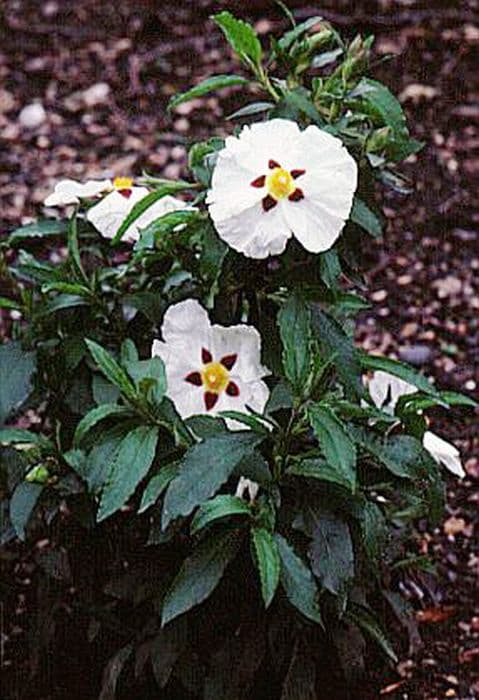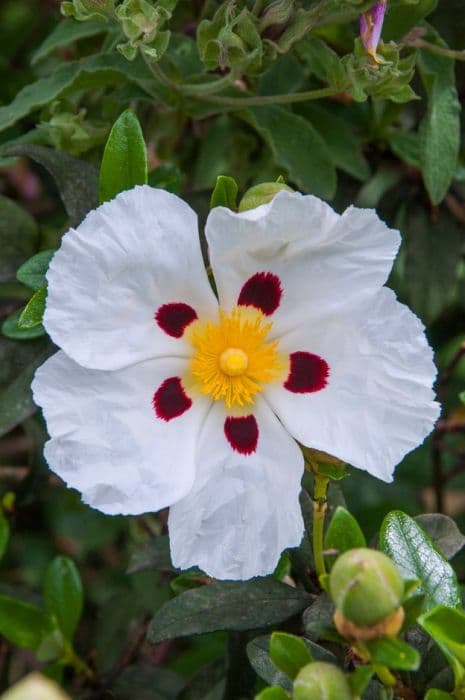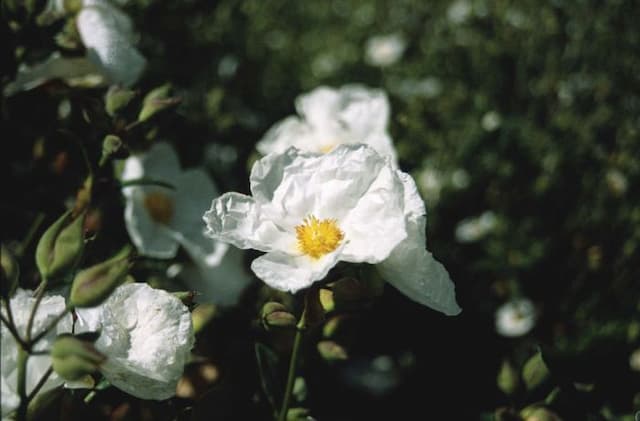Rock Rose Helianthemum 'Rhodanthe Carneum'

ABOUT
The Helianthemum 'Rhodanthe Carneum', commonly known as the Rock Rose, is a visually striking plant with a stunning display of flowers and foliage. The plant boasts a mound of small, shiny, and evergreen leaves that create a lush backdrop for the flowers. These leaves often have a dark green hue, with a slightly leathery texture that gives the plant a robust and hearty appearance. The Rock Rose is perhaps best known for its beautiful flowers, which bloom profusely under favorable conditions. The blossoms are composed of delicate, paper-like petals that come in a soft pink shade, centered with prominent yellow stamens that add a contrasting pop of color. The flowers have a classic, simple shape with five petals radiating around the center, creating an effect reminiscent of wild roses. The flowering period of the Rock Rose is normally in the spring to early summer, during which time it is covered with an abundance of blooms. Each flower opens up to the sunlight and can create a carpet of color that is truly eye-catching. The combination of the plant's vibrant green foliage and the soft pink flowers contribute to its overall charm and make it a favorite among garden enthusiasts who seek to add a touch of natural beauty to their landscapes.
About this plant
 Names
NamesFamily
Cistaceae
Synonyms
Rock Rose, Sunrose
Common names
Helianthemum 'Rhodanthe Carneum'.
 Toxicity
ToxicityTo humans
The common name for Helianthemum 'Rhodanthe Carneum' is rock rose. To the best of my knowledge, rock rose is not commonly known for being toxic to humans. However, like with any plant, some individuals may have allergic reactions or sensitivities. It is always advisable to handle plants with care and avoid ingesting any part of a plant unless it is known to be edible and safe.
To pets
Rock rose is not typically listed as toxic to pets. However, each animal may react differently to various plants, and some pets could potentially experience mild stomach upset if they consume a part of this plant. As a precaution, it's always best to keep an eye on pets around plants and to discourage them from eating any non-food plants. If you suspect your pet has ingested a potentially toxic substance, please contact your veterinarian or an animal poison control service immediately.
 Characteristics
CharacteristicsLife cycle
Perennials
Foliage type
Evergreen
Color of leaves
Green
Flower color
Pink
Height
1 feet (0.3 meters)
Spread
2 feet (0.6 meters)
Plant type
Shrub
Hardiness zones
5
Native area
Mediterranean
Benefits
 General Benefits
General Benefits- Attracts Pollinators: Helianthemum 'Rhodanthe Carneum', commonly known as rock rose, is known to attract bees and butterflies, which are vital for pollination.
- Drought Tolerance: Once established, rock rose is highly drought-tolerant, making it an excellent choice for xeriscaping and water-wise gardens.
- Low Maintenance: This plant requires minimal care once established, making it a perfect option for gardeners looking for low-maintenance landscaping.
- Ground Cover: Rock rose can serve as an effective ground cover, reducing soil erosion and competing with weeds.
- Sun-loving: It thrives in full sun, making it suitable for sunny spots in the garden where many other plants might struggle.
- Attractive Flowers: Rock rose features showy, colorful blooms that enhance the visual appeal of any garden space.
- Wildlife Habitat: Provides shelter and food for certain species of wildlife, contributing to biodiversity.
- Adaptable: Rock rose can adapt to a variety of soil types, although it prefers well-drained soils.
 Medical Properties
Medical PropertiesThis plant is not used for medical purposes.
 Air-purifying Qualities
Air-purifying QualitiesThis plant is not specifically known for air purifying qualities.
 Other Uses
Other Uses- Photographic subjects: Due to its vibrant pink flowers, the Rock Rose can be used as a photogenic subject for nature photography and botanical illustrations.
- Companion planting: Rock Rose can be planted alongside vegetables like tomatoes and peppers as an ornamental companion that can attract pollinators to the garden.
- Educational tools: Botany and horticulture programs can use the Rock Rose to demonstrate plant growth habits and the cultivation of sun-loving perennials.
- Culinary garnish: The flowers of the Rock Rose, while not widely known for their flavor, could potentially be used as an edible garnish to add color to salads or desserts.
- Natural dye: The petals of the Rock Rose might be used to create a natural dye for fabrics or art projects, although the color fastness and intensity would need experimentation.
- Art and crafts: Dried flowers of the Rock Rose can be used in making bookmarks, greeting cards, or any paper crafts where a floral accent is desired.
- Garden design element: Its mounding growth habit allows it to be used in rock gardens or as a ground cover that provides a flush of color.
- Aromatherapy: While not a primary use, the Rock Rose could contribute a subtle fragrance to an outdoor aromatherapy garden space.
- Beekeeping attraction: The Rock Rose can be planted in a beekeeper's garden to help attract bees and promote a healthy bee habitat.
- Theme gardens: Can be used in Mediterranean-themed gardens to maintain an authentic aesthetic that aligns with the plant's origins.
Interesting Facts
 Feng Shui
Feng ShuiThe Rock Rose is not used in Feng Shui practice.
 Zodiac Sign Compitability
Zodiac Sign CompitabilityThe Rock Rose is not used in astrology practice.
 Plant Symbolism
Plant Symbolism- Endurance and Survival: The Helianthemum, commonly known as Rock Rose, has a natural ability to withstand challenging conditions and poor soils, which symbolizes strong survival instincts and the ability to endure difficult situations.
- Resilience: Rock Rose bounces back and blooms even after experiencing drought or fires, symbolizing resilience and the capacity for recovery after hardship or trauma.
- Beauty amidst adversity: With its delicate appearance and ability to thrive where other plants might fail, Rock Rose exemplifies finding and showcasing beauty despite adversity.
- Protection: In historical contexts and some folk traditions, the Rock Rose was believed to offer protection from evil, due to its hardy nature and its use in traditional medicine for healing purposes.
 Water
WaterThe Rock Rose should be watered thoroughly, allowing the water to soak into the soil, then let the upper inch of soil dry out before watering again. In general, watering once every 7 to 10 days during the active growing season should suffice. During the winter or in cooler weather, you can reduce the watering frequency. It's important to avoid over-watering; approximately one gallon every week or two, depending on the weather conditions, should be adequate for an established plant.
 Light
LightRock Rose thrives best in full sunlight, where it can receive at least six hours of direct light daily. The plant prefers a south-facing exposure that offers abundant light throughout the day, ensuring vibrant blooms and healthy growth. Avoid placing it in total shade as this would hinder its flowering potential and overall vitality.
 Temperature
TemperatureRock Rose does well in a wide range of temperatures but prefers to be in conditions between 60°F and 80°F. It can survive temperatures as low as 20°F but should be protected from prolonged freezing conditions. The ideal temperature promotes good flowering and plant health.
 Pruning
PruningRock Rose should be pruned to maintain its shape and encourage denser growth. The best time to prune is in early spring, just before new growth begins. Remove any dead or damaged branches, and lightly trim back the plant to keep it compact. Pruning is typically needed once per year.
 Cleaning
CleaningAs needed
 Soil
SoilRock Rose prefers well-draining sandy or loamy soil with a slightly acidic to neutral pH of 6.0 to 7.5. A mix of one part sand or perlite to two parts peat or compost is ideal for this drought-tolerant plant.
 Repotting
RepottingRock Rose should be repotted every two to three years or when it outgrows its current pot, whichever comes first. Avoid overly large pots to prevent water accumulation around the roots.
 Humidity & Misting
Humidity & MistingRock Rose thrives in moderate to low humidity conditions and does not require high humidity to grow well. Average room humidity is generally sufficient for this sun-loving plant.
 Suitable locations
Suitable locationsIndoor
Place Rock Rose in bright, direct sunlight indoors for best growth.
Outdoor
Ensure full sun and well-draining soil for Rock Rose outdoors.
Hardiness zone
5-8 USDA
 Life cycle
Life cycleHelianthemum 'Rhodanthe Carneum', commonly known as the Rock Rose, begins its life as a seed that germinates in warm, well-drained soil, typically in the spring. The seedling stage involves the development of a root system and the first true leaves, which enable photosynthesis. As it enters the vegetative stage, the rock rose produces a low-growing mound of foliage and prepares to flower. The flowering stage occurs in late spring to early summer, when the rock rose displays its pink blooms that attract pollinators. Following pollination, the plant produces small, dry capsules containing seeds, marking the reproductive stage. Finally, after seed dispersal, the rock rose may enter a period of dormancy, particularly in hot or dry climates, before starting a new growth cycle the following season.
 Propogation
PropogationPropogation time
Spring to Summer
Propogation: The Rock Rose 'Rhodanthe Carneum', popular for its attractive blooms and resilience, is commonly propagated through cuttings. This method is favored as it tends to yield more consistent results than seeds. The best time to take cuttings for propagation is in the late spring or early summer when the plant is actively growing. To propagate Rock Rose from cuttings, select a healthy, non-flowering stem and cut a section about 4 to 6 inches (approximately 10 to 15 centimeters) long. Strip the lower leaves, dip the cut end in rooting hormone, and then insert it into a pot filled with a mixture of perlite and peat moss to encourage root growth. Maintain the cutting in a warm, humid environment with indirect sunlight, ensuring the soil stays moist but not waterlogged. Roots typically develop within a few weeks, after which the new plant can be transplanted to a larger pot or directly into the garden.









